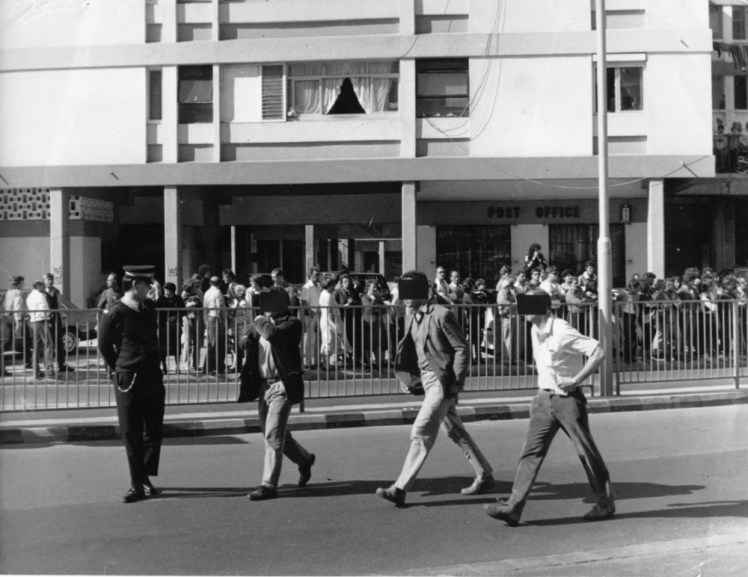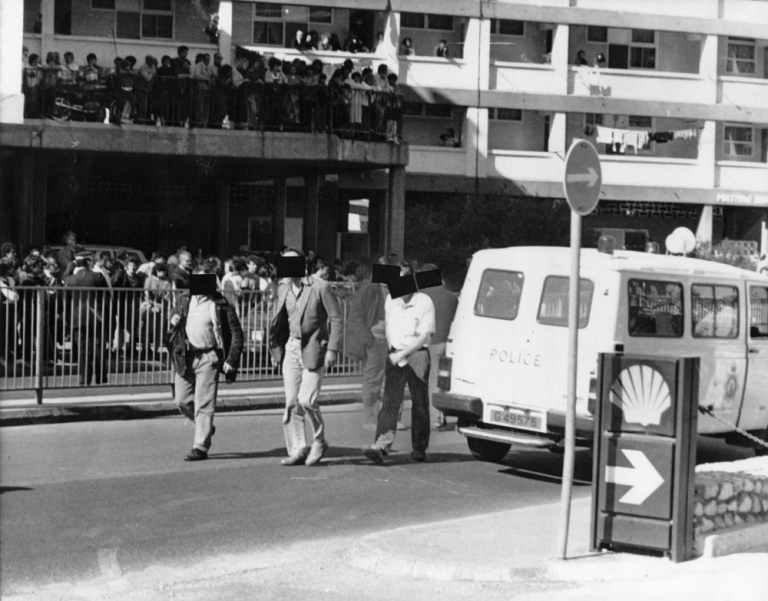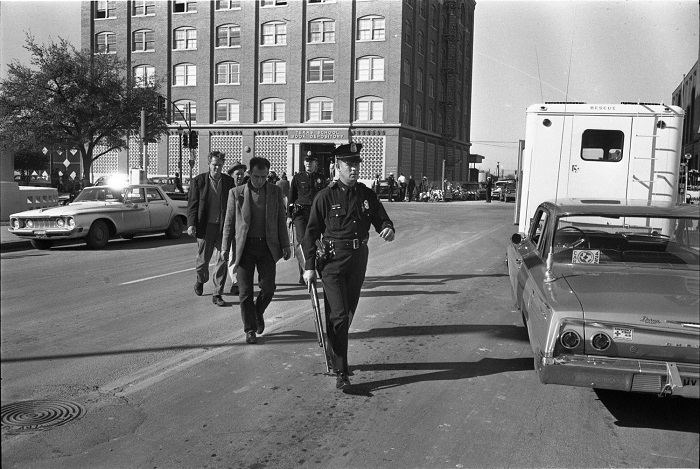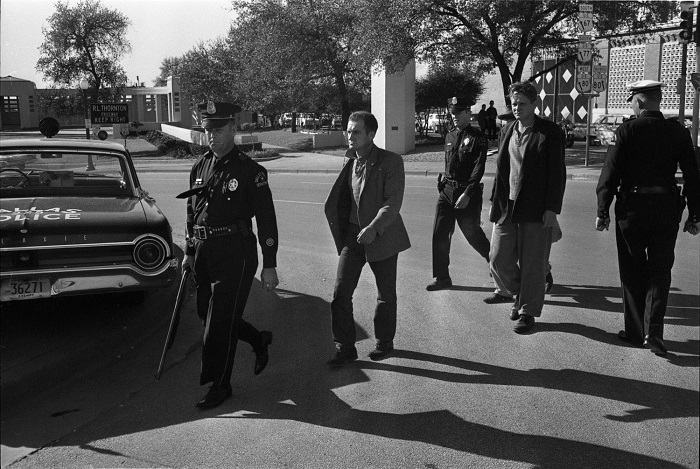1988 -- British elite regiment, the SAS (counter terrorism unit), are given 'shoot to kill' orders from the Thatcher government -- concerning operational IRA terrorist cells -- on the British mainland. A big deal. British military are effectively given [A] secret order to kill enemy combatant's -- a landmark case in the use of force by the state.
Operation Flavius -- Operation Flavius was a military operation in which three members of a Provisional Irish Republican Army (IRA) cell were shot dead by undercover members of the British Special Air Service (SAS) in Gibraltar on 6 March 1988.[1][2] The three—Seán Savage, Daniel McCann, and Mairéad Farrell (members of Provisional IRA Belfast Brigade)—were believed to be mounting a car bomb attack on British military personnel in Gibraltar. Plain-clothed SAS soldiers approached them in the forecourt of a petrol station, then opened fire, killing them. All three were found to be unarmed, and no bomb was discovered in Savage's car, leading to accusations that the British government had conspired to murder them. An inquest in Gibraltar ruled that the SAS had acted lawfully, while the European Court of Human Rights held that, although there had been no conspiracy, the planning and control of the operation was so flawed as to make the use of lethal force almost inevitable.
https://en.wikipedia.org/wiki/Operation_Flaviushttps://powerbase.info/index.php/The_Truth_on_the_RocksAdditionally Thames presented technical evidence from Lt Col George Styles a former British Army bomb disposal expert who had served in Ireland. Styles disclosed that any bomb disposal expert would have "quickly seen that (the car) carried no significant weight of explosives". Some people had talked of the supposed bomb being set off by remote control. But according to `Death on the Rock' "not mentioned was the fact that the car was almost a mile and a half from the point where the terrorists died, with buildings and the city wall in between". Styles thought that this would make it "very unlikely indeed" that the bomb could have been set off by remote control. The programme also revealed that "according to the Gibraltar police who were involved, the area of the Renault car was only cleared at 4pm after the three terrorists had been killed and at least two hours after the car was parked."
Just over 24 hours after the programme was broad-cast the campaign against the eyewitness, Carmen Proetta, had begun. The headlines included: "The truth about SAS ambush `witness' " (Daily Mail, "Shame of the SAS smear girl" (the Star), "Trial by TV Carmen is Escort Girl boss" (Daily Express) and the, by now infamous, headline from the Sun, "The Tart of Gib." (30.4.88)
The Sun alleged that Proetta "used to be a prostitute". The Daily Mail claimed that she is "a director of a Spanish escort agency" and "her fellow directors are wanted in Britain for alleged conspiracy and credit card frauds". The Daily Express, Daily Record, Sun, Star and the Sunday Times also carried these allegations. The Sun claimed that "police say both Carmen and her husband, 47, have criminal records on Gibraltar". The Daily Express, the Daily Mail and the Sun alleged that her and her husband were `anti-British'. The Star went so far as to claim that Carmen Proetta "campaigns for Spanish rule in Gibraltar". And the Daily Telegraph alleged that "several residents of the colony, who would not be named, had claimed she was one of only 44 Gibraltarians to vote to end British Rule in the 1967 referendum". This was repeated by Today (30.4.88) and the Sunday Telegraph (1.5.88)
Michael Fielder, the journalist who wrote the story in the Sun, told the Dublin-based Magill that:
"dozens of people including a senior police officer' told him Carmen Proetta was a prostitute.
In fact, the only `senior police officer' quoted in the Sun article, Chief Inspector Glen Viagas, has told Magill he was misquoted in the article. `I speak to many journalists from many newspapers' he said. `I am the police press officer. I do not remember what I say to each of them, but you can take it that the story is inaccurate.' "[5]
As for Proetta being an "Escort girl boss" as the Express claimed. The Observer revealed that Proetta: "used her qualification as a Spanish resident to help two non-Spaniards set up a firm called Eve International, whose purpose is stated on company documents to be `providing escorts and tourists promotion services.' She renounced her shares and involvement in a legal document dated 14 March 1985." When it comes to the allegations about the Proettas alleged criminal records Magill revealed:
"the `senior police officer' named in the Sun as having confirmed that the Proettas have criminal records in Gibraltar has denied to Magill that he said any such thing to the Sun. He would never divulge information about police dealings with any individual to a newspaper, regardless of the circumstances, he says"
The allegation that several Gibraltarians had claimed that Proetta had voted against the British link is denied by Carmen Proetta. "She says she dislikes politics and has never voted in her life." (Magill) The Daily Telegraph appeared to have forgotten that voting is by secret ballot.
The origin of the smear was according to the Observer a freelance journalist called Nigel Bowden who supplied Fleet Street with the story about Eve International. "He was astonished, however, by the gravity of the extra information added by the Sun." (Observer 8.5.88)
If this is an example of a smear mainly created by the press itself it also seems that some `official sources' were not above commenting on this witness. On May the 29th the Mail on Sunday quoting "government sources" reported that Carmen Proetta would refuse to give evidence at the inquest. On thi, Proetta commented that the report "looked like another attempt to smear her by implying that she was hesitant about her evidence." (Independent 30.5.88) She would, she said, be at the inquest.
On the 1st and 8th of May the Sunday Times published detailed allegations that the programme `Death on the Rock' had distorted and omitted evidence which was inconvenient. They claimed that key witnesses shown in it were complaining that "their views were not accurately reported" and that Thames's evidence was "crumbling fast" (1.5.88).
The Sunday Times Insight Team reported a "crucial statement" made by the English Lawyer Stephen Bullock before he was interviewed for the programme "when his memory was much fresher". He had told them "categorically" that the police car he saw had:
`five uniformed officer in it', not plainclothes SAS men. It had pulled up alongside him, perhaps 100 yards away from the garage, as two SAS men travelling on foot had raced along the pavement to the garage. The volley of shots, he said, rang out as the police car turned on its siren and raced towarods the petrol station.
So Proetta's evidence that the SAS men got out of the car outside the garage and shot the terrorists is contradicted by Bullock.
Insight was also given Bullock's account about the terrorists raising their hands.... He said McCann's arms were `outstretched trying to shield himself' and not, as Proetta claims, in surrender.' " (1.5.880)
One problem for this account is that Bullock and Proetta "were talking of two different police cars".[6] Another is that Bullock was more than a hundred yards away from the scene and simply "didn't know" whether McCann was surrendering or defending himself. He told Ed Moloney of the Dublin-based Sun-day Tribune "I emphatically deny that's what I said. I told the Sunday Times I just didn't know"[7]
Insight had reported Josie Celecia as saying that Proetta's account was "ridiculous" and accused the television programme of missing out this inconvenient testimony. But the Sunday Tribune reported Celecia as being "quite distressed" by the Sunday Times report. She told them "I totally reject suggestions... that I described the evidence of Carmen Proetta as ridiculous" (15.5.88)
Insight also consulted Lt Col. George Styles the former bomb disposal expert who had acted as a consultant for Death on the Rock. He was reported to be an "angry" man who was writing "a letter of complaint to Thames Television" with "a copy... to the Prime minister" (1.5.88) complaining that two of his views had been missed from the programme. Styles `complaints' centred on two points. Firstly, his disagreement with Carmen Proetta which was over whether Farrell and McCann had raised their hands in surrender or had done so because of the impact of the bullets. Secondly "his view that a red Fiesta van parked by the IRA team at the border was within range of a remote control device and the security forces had no way of knowing if that vehicle contained a bomb" (Sunday Times 1.5.88)
But, in fact, Styles's disagreement with Proetta was in the programme and the only people he was `angry' with were the Insight team. David Elstein, Director of Programmes at Thames TV, writing in the Sunday Times argued that all their charges were "without foundation". He commented:
"the reference to the possibility of a second bomb relates to Styles's view that perhaps there could of been a bomb in the car that the terrorists had left love the border in Spain to use for their getaway.
Neither Sir Geoffrey Howe's statement in the House of Commons nor any on-or-off-the-record statement from the government or defence sources or the Spanish police ever referred to this possibility. Accordingly we did not include this section or Styles's interview" (8.5.88).
The week after the Insight report of the first of May, the Observer reported that Styles had a "long telephone conversation" with Chris Oxley the Producer of `Death on the Rock'. He told Oxley "you don't have to apologise to me" and that "the thing which had made him most cross, he said, was the way the press had gone for Carmen Proetta `because, you know, what she said was true' " (8.5.88)
Only on the day after the shootings did the House of Commons hear Geoffrey Howe admit:
'those killed were subsequently found not to have been carrying arms. The parked car... did not contain an explosive device.'Stephen Bulloch, a British Lawyer, witnessed a man wearing a bright yellow short-sleeved shirt standing with both hands outstretched holding a gun firing rapidly into another man with blonde hair, wearing a white shirt, who was falling backwards, with his hands raised in surrender, falling in almost slow motion, he went right down, and the firing continued. He was still being shot at as he went down. He estimated the distance between the two men as being 4ft.
30:15


The blurring roles of Police officers aiding military combatants assassination of civilians: quite interesting. When I saw the pictures of SAS troops being aided in their removal from the scene by civilian Police officers it struck a startling similarity to the 3 tramps photos of dealey plaza 11/22/63


